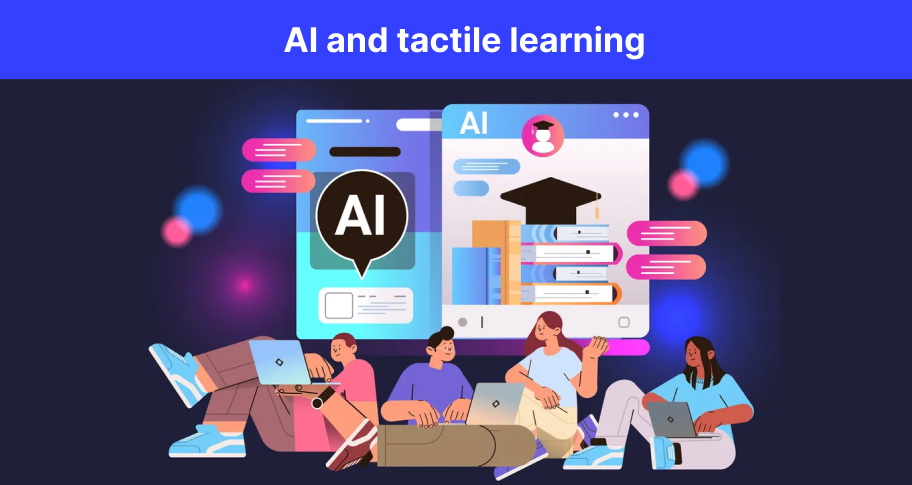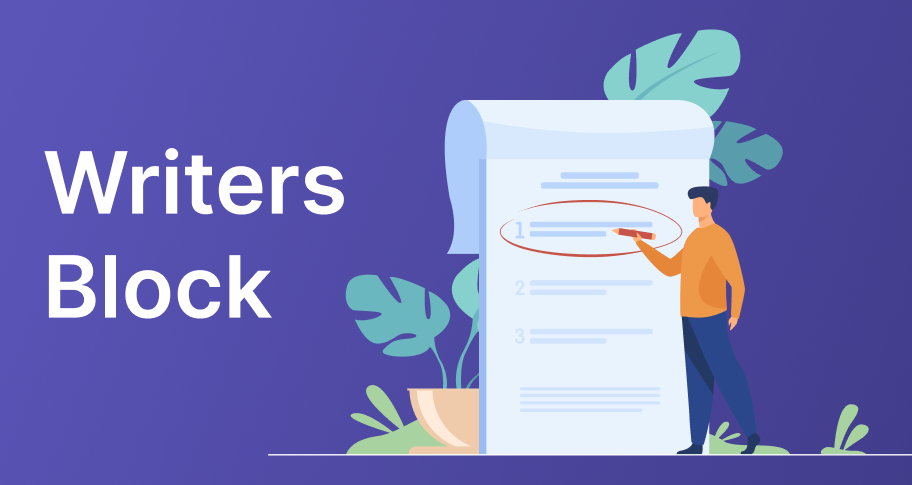Introduction
When it comes to landing that dream job, there is nothing like a well-crafted resume to get your foot in the door. Why does it work? The resume is your personal billboard: it tells the hiring manager everything he needs to know about you to make him want to pick up the phone and give you a call. It is your very own personal marketing tool. When optimized correctly, it can dramatically increase your chances of getting HR interested in finding out more about you. In this guide, we’ll give you the essential tips and insights to create a resume that stands out.
Definition and Purpose
A resume is a concise (and we mean concise—as in brief, laser-focused, to the point) document that summarizes your professional profile (think bullet points). It should include the main highlights of your education, experiences, skills, and accomplishments.
Its purpose is simple: it acts as a quick and easy way for you to show off your qualifications for a specific role or career field. Its primary role in job applications is to make the case for why you are the best candidate.
In today’s digital world, your resume is really just an invitation to HR to get to know you better. That’s why it is a great best practice to include links on your resume that can give HR a fuller picture of who you are. This is where having a LinkedIn profile can really help: it gives you a digital space all your own where you can bring your whole CV to life in a full-fledged way.
Leveraging LinkedIn and Other Networking Platforms
LinkedIn and other professional networking platforms are invaluable on your resume. Why? They show that you know how to be a professional. Aside from posting your LinkedIn on your resume, however, it is also just a smart idea to be on LinkedIn because it can help you connect with industry professionals, get in on relevant groups, access job listings before they hit the wires, and get your profile in front of people so that hiring managers start looking at you before you even know it. On platforms like LinkedIn, you get to share your personal or professional insights and open doors to new opportunities.
If you don’t have a LinkedIn profile, get one. Fill it out. Put the link atop your resume along with the rest of your contact information.
Also, if you want to be a successful professional, here’s another tip to consider for your resume: get rid of the cutesy high school-era email you’ve had for years and get a professional one. The more you look like a pro, the more the pros will want to look at you.
Creating a Professional Email Address and Online Presence
Therefore, that’s why we say that a professional email address is a must-have for job applications and resumes. It shows you’re serious enough about your career that you’re going to set aside childish things.
Similarly, an online presence on professional networking sites like LinkedIn or Indeed will improve your visibility with potential employers. Instead of trying to cram everything onto your resume, link to your professional profile online and show off your whole CV there.
Evolution of Resumes
The resume has undergone significant evolution, especially with digital advancements. Traditionally, resumes were simple, text-based documents. Today, they can incorporate various elements such as digital portfolios, hyperlinks to professional profiles, and even multimedia components. This evolution reflects the changing nature of job applications and the increasing importance of online presence in the recruitment process. Don’t wait for HR to stumble upon something brilliant you’ve done. Show it off upfront using the digital tools available.
Different Types of Resumes
When we say there are different types of resumes, what we really mean is that there are different ways to structure or frame them. Some people like to think in terms of timelines: they start with where they are now and work backwards to describe their professional experience. Others like to think in terms of skills and knowledge. Instead of focusing on jobs they’ve held over the years, they highlight the skills they have now.
Your resume should be tailored to the specific job you want. If it’s skills that will make your resume pop, then choose a functional layout. If it’s experience, go with chronological. Just keep in mind that your resume type will change depending on where you’re applying. In any case, here are the three main types to try:
Chronological
This is the most traditional format. In this type, you list your work history in reverse chronological order. It is ideal for those with a clear and progressive career path in a specific field.
Functional
Also known as a skills-based resume, this type focuses on your skills and experiences instead of your job history. It can be a great way to structure your resume if there are gaps in your employment and not a lot of professional experience to speak of. Or, if you’re just making a career change, you should go with this layout.
Hybrid
With this type, you combine elements of both chronological and functional resumes. The hybrid resume highlights your skills and accomplishments upfront but still gives a detailed work history, too. This format is good for candidates with a mix of traditional career paths and varied skills.
So remember: Each resume type serves different purposes and caters to various career needs. Choose the right format to reflect your own professional identity and goals.
Resume Format
Having a solid resume structure is just what you need to get a job interview. Understanding and effectively presenting the key components of that resume will set you apart from other candidates. Here’s a closer look at the most important resume components that will help you get that call back.
Contact Information
The foundation of your resume begins with your contact information. This should be a basic no-brainer, but just for the record it should include accurate and up-to-date information—i.e., your professional details such as your full name, phone number, email address, and LinkedIn profile. The point is to make it so that potential employers can easily reach you. Tip: Keep this polished. It’s the first thing they see.
Work Experience
Your work history is literally your professional saga. We all have one. But save sagas for the water cooler. There’s just not room for them on your resume. Stick to the most relevant work experience when applying for a job and list your experiences in reverse chronological order, starting with your most recent job. For each job, include your position, title, the company’s name, the duration of your employment, and a list of your what you did for that job or what you achieved that is worth noting. Again, this needs to be brief—so be very selective! Tip: Use action verbs and quantify your accomplishments to demonstrate your impact on previous roles effectively.
Educational Background
This section is where you get to list your academic credentials if you have them. Put your degrees in reverse chronological order, along with the name of each institution, what you earned, and the date(s) of graduation. Tip: If you have recently graduated and have less work experience, place your educational background section before your work experience.
Skills and Certifications
Listing your relevant skills and qualifications is naturally another important component of your professional profile. This is what really shows (more than anything else) that you have what it takes to excel in the job you’re seeking. Try to include a mix of hard and soft skills if you have ones that are especially relevant to the position. Tip: If you hold any relevant certifications licenses, list them here.
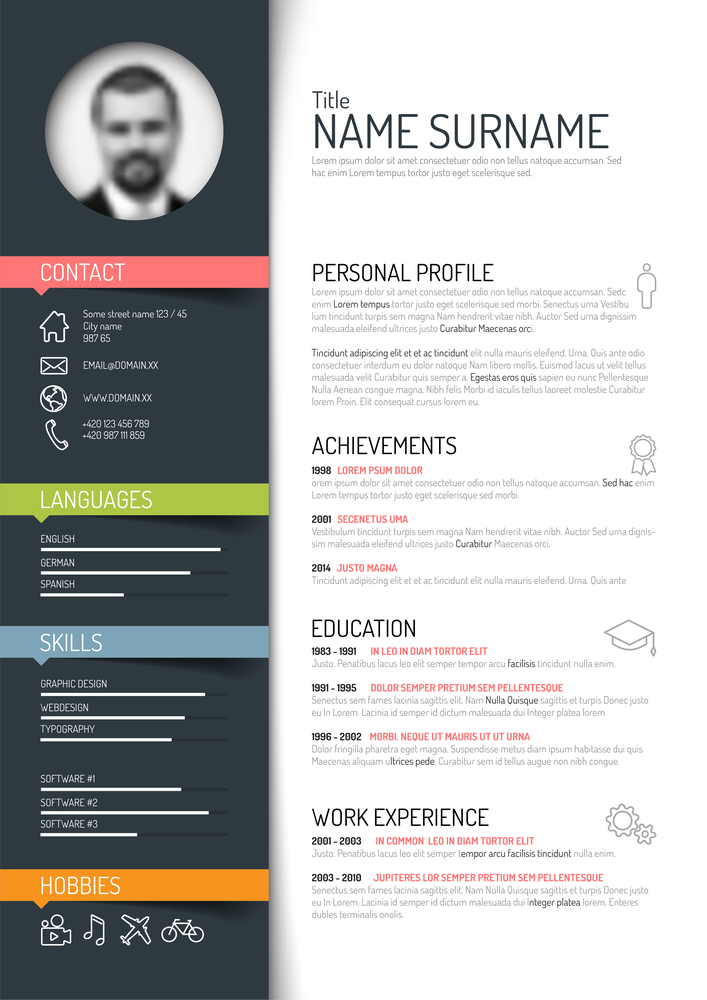
Industry-Specific Resume
Creating a one-size-fits-all resume is a common mistake first-time job applicants make. These are easily identifiable to hiring managers: generic and way-too-general CVs show HR that you haven’t bothered to be serious about honing in on what makes you a good fit for them.
Therefore, to increase your chances of getting noticed, customize resume! We can’t emphasize that enough. Yes, it takes time. Yes, it means more work on your end. But in order to get work in the field, you have to put in the work on the back end first.
Doing this also helps you better understand the industry and see for yourself that you have the specific skills and experiences that employers are looking for.
With that in mind, here are a few tips for customizing a resume that is industry-specific and uses the appropriate keywords and phrases.
- Research the Industry: Start by researching the industry you want to get into. Know the skills most desired by employers in that field. Learn the experiences; get the qualifications that are most valued. Look at job listings, go to company websites, talk to people there, network on LinkedIn. Geta sense of what is trending in the industry and what businesses want from potential hires.
- Customize Your Professional Summary: Your professional summary should match your target industry. Any experiences you highlight should be 100% relevant. Skills you list should directly align with the industry’s needs. Don’t waste time or space with superfluous details that have nothing to do with the industry. This section is your five-second elevator pitch; make it count by directly addressing how you can contribute to potential employers.
- Highlight Relevant Work Experience: You probably have a range of experiences—everybody does. Focus only on those that apply fundamentally to this specific industry. When describing your work history, highlight the positions and responsibilities that best match the industry you want to get into. Use very concise and very specific examples of your accomplishments to show you have experience and expertise.
Resume Keywords and Phrases
- Use Industry-Relevant Keywords: Many companies use Applicant Tracking Systems (ATS) to screen resumes before they actually reach a human reader. These systems are designed to search for specific keywords related to the job. In your resume, include industry-relevant, industry-specific keywords and phrases found in the job listing and on industry-specific websites. This is what gets your resume past the ATS screeners. That’s why we say: to get a job in a specific industry, you want to create an industry-specific resume.
- Speak the Industry’s Language: Every industry has its buzzwords. Get familiar with the language commonly used in your target industry. Use these terms in your resume. The more industry-friendly language you use, the more chance you’ll have with ATS.
- Showcase Industry-Specific Skills and Certifications: List the skills and certifications you have that you know are valued in the industry. Whether they are technical skills for IT roles, analytical skills for finance positions, or creative skills for design jobs, be sure to highlight the skills that will make you a valuable asset in the specific sector.
When you customize your resume for different industries and strategically use keywords and phrases, you increase the chances of your resume standing out. This targeted approach shows potential employers that you’re qualified, knowledgeable, experienced, and familiar with the industry.
View 120,000+ High Quality Essay Examples
Learn-by-example to improve your academic writing
Dos and Don’ts of Resume Writing
Crafting a resume that catches the eye of potential employers involves understanding what to include for maximum impact and what pitfalls to avoid. So without further ado, here are some resume writing tips, best practices and common resume mistakes to be aware of.
Best Practices: What to Include in Your Resume
Do:
- Tailor Your Resume: Customize your resume for the job you’re applying for. Highlight the skills and experiences that align with the job description.
- Use a Clear, Professional Format: Opt for a clean, easy-to-read layout with consistent formatting. Bullet points are an acceptable way to list your skills, experiences, achievements and responsibilities.
- Quantify Your Achievements: Where possible, add numbers to your accomplishments to give a clearer picture of your impact (e.g., increased sales by 20%).
- Include Keywords: Use industry-specific keywords and phrases from the job listing to make your resume ATS-friendly.
- Focus on Results: Emphasize the outcomes of your work, not just your responsibilities. Show how you contributed to your previous employers’ success. Give specific examples.
- Keep It Concise: Limit your resume to 1-2 pages, and include only the most relevant and recent experiences.
Don’t:
- Include Irrelevant Information: Don’t waste space on unrelated work experiences or personal information that doesn’t support your job application.
- Use Generic Descriptions: Avoid vague statements. Be specific about what you did and how you did it.
- Lie or Exaggerate: Be honest about your experiences and qualifications. Misrepresentations can lead to disqualification or job termination.
- Ignore Soft Skills: While technical skills are important, don’t forget to include relevant soft skills (e.g., leadership, teamwork) that are valuable in any role.
- Submit Without Proofreading: Typos and grammatical errors will raise flags about your commitment to professionalism. Always proofread your resume or have someone else review it.
- Use an Unprofessional Email Address: Don’t look like a newbie; an inappropriate email address may make a bad impression. Get a new one if yours looks at all immature.
Common Mistakes: Pitfalls to Avoid in Resume Writing
Don’t overload your resume, CV, or professional profile with text. Long paragraphs don’t make for easy reading. Use bullet points so that your resume can be skimmed quickly.
Be consistent with your formatting. Inconsistent use of fonts, sizes, and styles can make your resume look unprofessional. Stick to one font and a logical layout.
Customize! Sending the same resume to every job application is a missed opportunity to show why you’re the ideal candidate for each specific role. Don’t slack off on this front.
Don’t forget keywords. Failing to include the appropriate words and phrases used in the industry, in the job listing, or on company websites can result in your resume being overlooked by ATS systems.
The Role of Digital Tools in Resume Creation
Digital tools like an online resume builder or optimization strategies for ATS systems are available to help with creating your professional profile. Here are some tips for how these tools can work for you.
Online Resume Builders
Online resume builders are digital platforms that provide users with templates, pre-written content, and design options to create professional resumes. These tools simplify the resume creation process by providing step-by-step guidance. Users can input their information using a conveniently structured format. This can help make so no important details are left out.
ATS Optimization
Applicant Tracking Systems are being used by more and more employers to screen resumes. Therefore, it’s important you create an ATS-friendly resume. Optimizing your resume for ATS involves several key steps:
- Keyword Research and Integration:
- Research: Review job listings in your field to identify commonly used keywords, such as desired skills, qualifications, and job titles.
- Integration: Incorporate these keywords naturally into your resume, especially in sections like your professional summary and skills list.
- Using Appropriate Resume File Formats:
- PDF vs. Word: PDFs are preferred for preserving formatting, but some ATS systems parse Word documents more effectively. Follow the employer’s submission guidelines if specified.
- Structuring Your Resume for ATS Readability:
- Logical Layout: Use a clean, straightforward format with headings for each section (e.g., Work Experience, Education) to ensure ATS can easily read your resume.
- Chronological Order: Present your work history and education in reverse chronological order for straightforward parsing.
- Avoiding Formatting Elements That Confuse ATS Software:
- Simple Formatting: Use standard fonts and avoid headers, footers, tables, or graphics, as these can disrupt ATS parsing. Clean and simple: this is what’s most effective.
- Bullet Points: Limit the use of fancy bullet points or symbols, as these may not be recognized by ATS.
You can use online resume builders to create a solid resume with ease. However, you also need to understand what ATS is going to be looking for. Thus, use the ATS-optimization techniques we have suggested so that your resume passes initial screenings, and your chances of securing an interview increase. If we take them together, these digital tools and strategies will make your CV stronger and elevate your odds of getting the job you want.
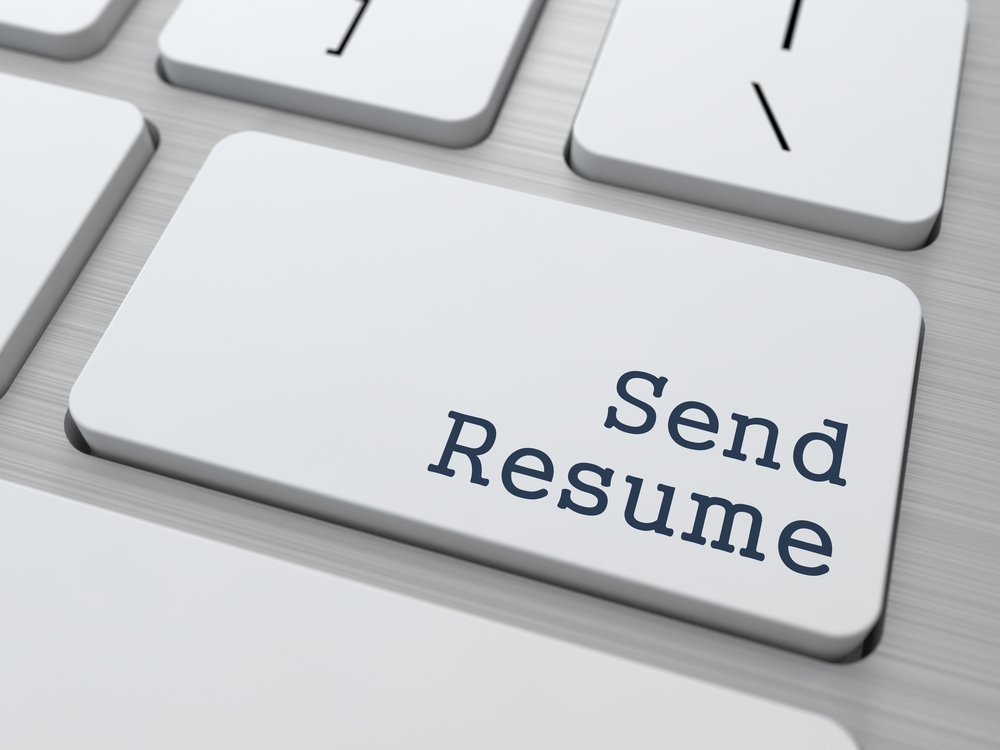
Other Tips
Resumes for Career Changers or Recent Graduates
Career changers and recent graduates face unique challenges when creating their resumes. For career changers, the focus should be on transferable skills and achievements that are relevant to the new field. They should highlight any related volunteer work, projects, or courses that can also bridge the experience gap. Recent graduates should emphasize academic accomplishments, extracurricular activities, internships, and any part-time work that demonstrates relevant skills and potential.
Creative Resume Templates and Design Strategies
In fields where creativity and design are valued, the visual layout of your resume can be as important as the content. Use creative resume templates and design strategies to help your resume stand out. However, make sure to maintain readability and professionalism, so that design enhancements aid in highlighting your qualifications but also don’t distract from them.
Resume Writing Services and Professional Review Options
For those seeking expert assistance, resume writing services and professional review options are here to help. These services can help articulate your experiences more effectively, make your resume ATS-friendly, and tailor your resume for your desired industry or role. Get professional help for any complex career transitions or if you’re competing in a highly specialized field and want support.
Crafting a Winning Cover Letter
A cover letter is another important component of the resume creating process. Your resume is really incomplete without it. It is like an opening salvo—a personalized introduction that quickly sums up your professional experience. Its main function is to complement your resume by giving a deeper, somewhat more human look into who you are, your qualifications, your experience or education or skills, and what value you might bring to the employer. Unlike the resume, which should be concise with bullet-points galore, the cover letter is your place to articulate in complete sentences and thoughts just how enthusiastic you are for the job, and what you can bring.
Importance of a Cover Letter
The resume cover letter is a way to make a good first impression. It shows the employer you have the ability to communicate, first of all. It also shows you have personality, drive, motivation—and all those other good things hiring managers look for. It gives context to your resume. In your cover letter, you can explain how your experiences and skills make you an ideal candidate for the position. It is also a space where you can show your interest in the specific role and company and why it appeals to you.
How to Write an Effective Cover Letter
Writing an effective cover letter involves some key steps. Here, we’ve broken them down into five.
Customization
Start by addressing the cover letter to the specific hiring manager or department head, if at all possible. A personalized greeting is more impactful than generic salutations. Research the company and the role to tailor your letter, showing how your background aligns with the company’s needs and culture.
Introduction
Your opening paragraph should get the reader’s attention. Briefly introduce yourself and express your enthusiasm for the position and the company. Mention how you learned about the job opening as a way to transition into discussing your qualifications. Try to stand out here.
Body
This section is where you detail your relevant experiences and skills and draw direct connections between your background and the job requirements. Use specific examples from your career to illustrate how you have successfully handled similar responsibilities or challenges. Use quantitative metrics when possible to highlight your achievements and to provide a tangible sense of how you contribute.
Company-Specific Value
Demonstrate your knowledge of the company and its industry. Show why you’re drawn to them and how you can contribute to their goals and challenges. Demonstrate that you have genuine interest in the organization.
Conclusion
Conclude your cover letter by summarizing your interest and readiness for the role. Express your readiness to discuss how you can contribute to the team in more detail during an interview. Thank the reader for considering your application and include a professional closing.
Remember, the resume cover letter should not simply repeat your resume. Instead, it should provide insights into your personality, work ethic, and professional aspirations. Tell your story and show how it fits in with the company. This is how you make the case for why you should be part of their team.
How to Write a Compelling Resume
Resume writing really is an art that requires careful consideration. Pay attention to how you use words, the content you create, the structure and format you use, and the tone you convey. A standout resume is one that cuts through the fat while at the same time highlights your achievements and the unique value you can bring. So let’s go over a few strategies you can apply to help you write a resume that gets you through the door.
Writing with Strong Action Verbs and Quantifiable Achievements
Begin each bullet point in your work experience section with strong action verbs. These make you sound confident and experienced. Words like “managed,” “led,” “developed,” “increased,” or “optimized” are all great for getting you off and running. Here are more if you want them. These verbs convey a sense of initiative and impact, and they give a sense of having contributed.
Another strategy is to quantify your achievements. For example, instead of saying “led a team,” specify the size of the team, the scope of the project, and the results the team achieved: “Led a team of 12 to deliver a cross-demographic marketing project that directly increased revenue by 15% within six months.”
Tailoring Your Resume to Specific Job Descriptions
A generic resume sent to multiple job openings is less likely to stand out. Instead, tailor your resume every time you apply somewhere new. Bring your experiences and skills into alignment with the specific job description that company posted for the position. Identify the key requirements and preferred qualifications listed by the employer and reflect these in your resume. If you can do this, you’ll get by ATS and on your way to the interview stage.
Highlighting Relevant Skills and Experiences for Each Position
Focus on the skills and experiences that are pertinent to the job. This may mean you have de-emphasize or omit some skills and experiences you possess. Don’t worry. If they are not relevant to the job posting, don’t mention them here. Use the job description as a guide. Structure your resume to highlight these aspects prominently.
Showcasing Your Accomplishments Strategically
Arrange your resume to draw attention to your most impressive accomplishments. This could mean placing your strongest professional experiences or achievements at the beginning of each section, or using a summary statement at the top of your resume to highlight your key qualifications. The goal is to immediately capture the hiring manager’s interest and encourage them to read on. Look back over our section on Types of Resumes—i.e., functional vs. chronological—to have a better idea of strategy.
Avoiding Common Resume Mistakes and Cliches
To get your resume to stand out for the right reasons, avoid common mistakes and cliches. Drop overused phrases such as “hard worker,” “team player,” or “go-getter,” as these phrases give zero insight into your actual qualifications. Avoid vague phrases like “experienced in” or “responsible for,” which don’t really give any specific information about what you accomplished. Zero in on actual accomplishments—don’t give vague talking points.
Be vigilant about proofreading to eliminate typos and grammatical errors. Make sure your formatting is professional and consistent. Always use a clear, readable font and have a simple, clean layout. Attention to these details reflects your professionalism and shows you know how to put yourself in the best possible light.
View 120,000+ High Quality Essay Examples
Learn-by-example to improve your academic writing
Resume Example with Cover Letter
Below is an example of a resume followed by a cover letter. This example will show you how you can structure your resume along with a cover letter that complements it. In this example, we highlight the applicant’s qualifications, experiences, and the specific skills that make her an ideal candidate for a job.
Resume Example
Molly Monroe-Peters
808 N. Main Rd. | Mountview, RI 55021 | (123) 456-7890 | [email protected] | LinkedIn: linkedin.com/in/mmpeters
Objective
Dedicated professional with over 5 years of experience in digital marketing with expertise in SEO, UX design, content creation, and social media strategy seeking to contribute to the growth and success of AI Company as a Digital Marketing Manager.
Professional Experience
Digital Marketing Specialist
Inward Corporation, Maytown, OH
June 2020 – Present
- Led a team of 4 in developing and executing a cross-demographic digital marketing strategy, resulting in a 40% increase in online traffic within a year.
- Managed SEO efforts, including keyword research and content optimization, achieving a 30% improvement in organic search rankings.
- Designed social media campaigns across multiple platforms (Facebook, Twitter, Instagram) that increased engagement by 50%.
- Coordinated with the sales team to develop marketing materials that contributed to a 20% increase in sales.
Marketing Coordinator
Daft Enterprises, Maytown, OH
May 2016 – May 2020
- Supported the marketing team in the creation and delivery of compelling email marketing campaigns, leading to a 15% rise in conversions.
- Assisted in the development and management of the company’s website content, improving user engagement by 25%.
- Analyzed market trends and prepared reports for the marketing director to inform strategic decisions.
Education
Bachelor of Science in Marketing
University of Kentucky
Graduated: May 2016
Skills
- Google Analytics, SEMrush, and HubSpot
- SEO, content marketing, and social media strategies
- Excellent skills in communication, leadership, teamwork, and project management
- Creative thinker with a data-driven approach to problem-solving
Certifications
- Google Analytics Certified
- HubSpot Content Marketing Certification
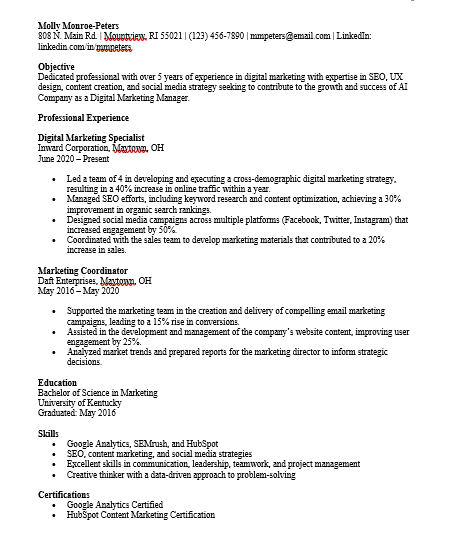
Cover Letter Example
Molly Monroe-Peters
808 N. Main Rd.
Mountview, RI 55021
(123) 456-7890
[email protected]
[Date]
[Employer’s Name]
AI Company
444 Business Rd.
Mountview, RI 55021
Dear [Employer’s Name],
I am writing to express my interest in the Digital Marketing Manager position at AI Company, as advertised on your careers page. With over 5 years of experience in digital marketing, including a successful track record at Inward Corporation and Daft Enterprises, I have great confidence in my ability to contribute to your team and help AI Company achieve its digital marketing goals.
At Inward Corporation, I led a team in developing a digital marketing strategy that resulted in a 40% increase in online traffic and a 30% improvement in organic search rankings within a year. My experience managing SEO efforts, creating content, and executing social media campaigns has given me a solid and robust skill set that I believe will be beneficial to your marketing efforts.
I am particularly drawn to AI Company because of its innovative approach to marketing and its commitment to creating impactful digital content. I am excited about the opportunity to bring my expertise in SEO, content creation, and social media strategy to your team, and I am eager to contribute to projects that drive engagement and growth.
Thank you for considering my application. I look forward to the opportunity to discuss how my background, skills, and enthusiasms align with the needs of AI Company. I am available at your convenience for an interview and can be reached at (123) 456-7890 or via email at [email protected].
Sincerely,
Molly Monre-Peters
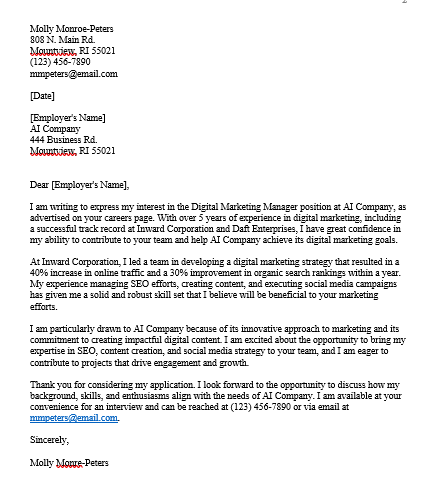
Following Up Effectively After Submitting Your Resume
Following up after submitting your resume and cover letter can show your interest and initiative. A polite and professional follow-up email or call is an acceptable way to make sure your application has been received. It’s also an acceptable way to reiterate your enthusiasm for the role. However, it’s just as important to respect the employer’s process and time frames and not to be pushy.
You Got the Call: Now What?
Common Interview Questions and Answers
Preparation is essential to interviewing well. Familiarize yourself with common interview questions and practice your answers in front of a mirror. This will help you present yourself confidently. Focus on questions that probe into your experiences. Think about your problem-solving abilities, and how you handle challenges. Practice so that your answers reflect your strengths and how they align with the job role.
Interview Preparation Tips and Resources
Effective interview preparation is more than just rehearsing answers, however. You actually need to research the company, get to know its culture, be ready to discuss how you can contribute to its goals, show your respect for its initiatives and achievements. Use available resources like mock interviews, professional workshops, and other online content to get a sense of strategies that will improve your interview performance. Pay attention to everything from body language to how you answer behavioral questions.
Conclusion
Throughout this article, we’ve examined what it takes to craft a winning resume and cover letter. We emphasized using action verbs and bullet points, tailoring your resume to specific job descriptions, making sure that your skills and experiences align closely with the requirements of the position you’re seeking. We’ve talked about why highlighting relevant skills and showing your accomplishments strategically helps to create a picture of yourself and your career. We also covered the common mistakes and clichés to avoid.
All in all, we’ve shown that a professional resume is an investment in your career—so don’t cheat yourself by trying to cut corners. It requires time and effort, but the payoff is well worth it when you land the job you’ve always wanted. A well-crafted resume and cover letter is where it all starts. If you want to get your foot in the door, there’s no better way than this one.
For anyone looking to further refine a resume, online resume builders offer free templates and guidance that can help you structure your resume. Professional resume writers like ours can also provide personalized assistance so that your resume and cover letter are optimized and customized for your target industry and company.
Putting in the time to create a professional resume is not something everyone can do—we know—and that’s why we’re here to help if you need us. Let us be your personal marketing tool. Whether you work with us, or use the strategies outlined in this article, you will get a resume that gets you through ATS screening, that catches the attention of that hiring manager, and that puts you in a position to get the job.
Remember, your resume is the first step in your job application. Make it strong, and let it open doors to new career opportunities.


